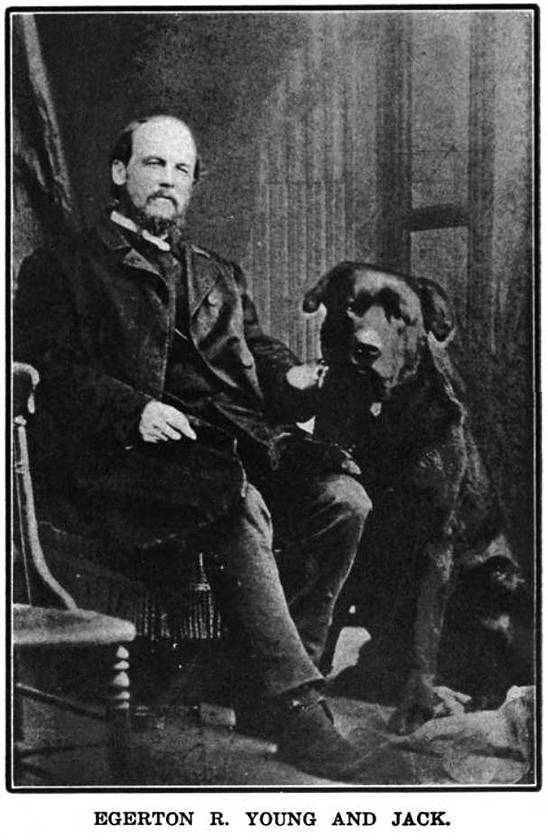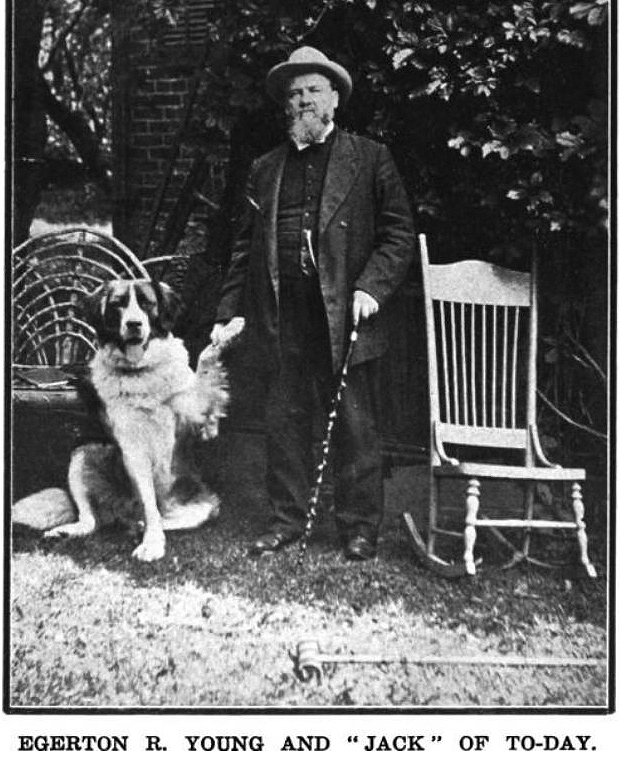[ Young / My Dogs in the Northland ]
This is a curious work (published 1902 by Fleming H. Revell [New York]) as regards the history of Newfoundlands and St. Bernards, for it in Young, a Canadian and a Methodist missionary, describes two of the many dogs he owned during his time in the Canadian northwoods. Young owned both a St. Bernard dog ("Jack") and a Newfoundland bitch ("Cuffy") simultaneously; several of his stories are about their interactions.
A photograph following p. 66 in this book shows Young, perhaps in his thirties at the time, with a dog identified in the caption as "Jack," which was the name of Young's St. Bernard, one of his favored dogs and the one discussed at greatest length in this book. The dog in the photo is short-coated, large-headed, and appears to be solid black.

At first I thought perhaps the printer had accidentally switched photographs during production of the book and this was really a photo of Cuffy the Newfoundland, but in one of the chapters discussing Jack the St. Bernard, Young explicitly refers to his coat as "of inky blackness" (87). (Cuffy the Newf, we learn later from Young, was also black, but as her coat was extremely curly the image in question cannot be a mislabeled image of her, as the dog in the picture has a coat showing essentially no curl at all.)
Perhaps Young was imposed upon? He explains that he wrote to friends asking them to send him a couple of large dogs for help with sled-pulling and other duties involving his missionary work, and it may be that Young mistook a Newf for a Saint. I am unaware of any black St. Bernards, although that may have been a possibility given the failed attempt to rejuventate St. Bernards by crosses with Newfoundlands during the 19th Century. It's also worth noting that Young reports that the friends whom he asked to send him some dogs were much amused at his request — perhaps they took their sense of humor another step? Young states that Jack and Cuffy came to him from "the Hon. Senator Sanford, of Hamilton, Ontario." William Eli Sanford was an important Canadian clothing manufacturer and importer and an important figure in the Canadian Methodist community; he became a Senator in 1887, about twenty years after he would have sent the dogs to Young.
There is another photo in this book that is identified in the "List of Illustrations" as "Dr Young and Cuffy," but on that page (following 126) is a photo of Young — several decades older than he appeared in the photo taken with Jack, and remember that Young owned Cuffy and Jack at the same time — with what clearly appears to be a St. Bernard (although with a longer coat than is typically seen today) seated next to him. The caption of this picture reads "Dr Young and the 'Jack' of To-Day," where "Jack" in quotation marks is clearly meant to reference the fact the dog is another St. Bernard.

Either Young was confused or imposed upon, or else there really are, or at least were, "black St. Bernards." (Saints — like Newfs — were much more loosely defined, as a breed, in the 19th Century; the Saint and Newf breed standards were developed only in the later 1880s; that would have been well before this book was published but well after the experiences recounted in it.)
Either way, we will never know quite what Cuffy the Newf looked like, other than Young's reference to her short, very curly coat and her black color.
Fair warning: Young was a man of his time, when methods for training dogs were, shall we say, extremely different from what they are now. Young's account of how he taught Cuffy to stop bringing her fish into the house to eat, and how he dealt with Jack's response to that lesson, is not easy reading for modern dog lovers.
The full text of Chapter VIII, "Cuffy, the Beautiful Newfoundland" (pp. 125 - 142) will appear in a new tab/window, for easier reading.
Young also owned another Newfoundland, Rover II or Kimo, whose story is told in Chapter XII of this volume, accessible here, also in a new window.
Thanks to Winnie Vogel, historian of the St. Bernard Club of America and owner of High Chateau Saints, for information relating to St. Bernards in the 19th Century.


